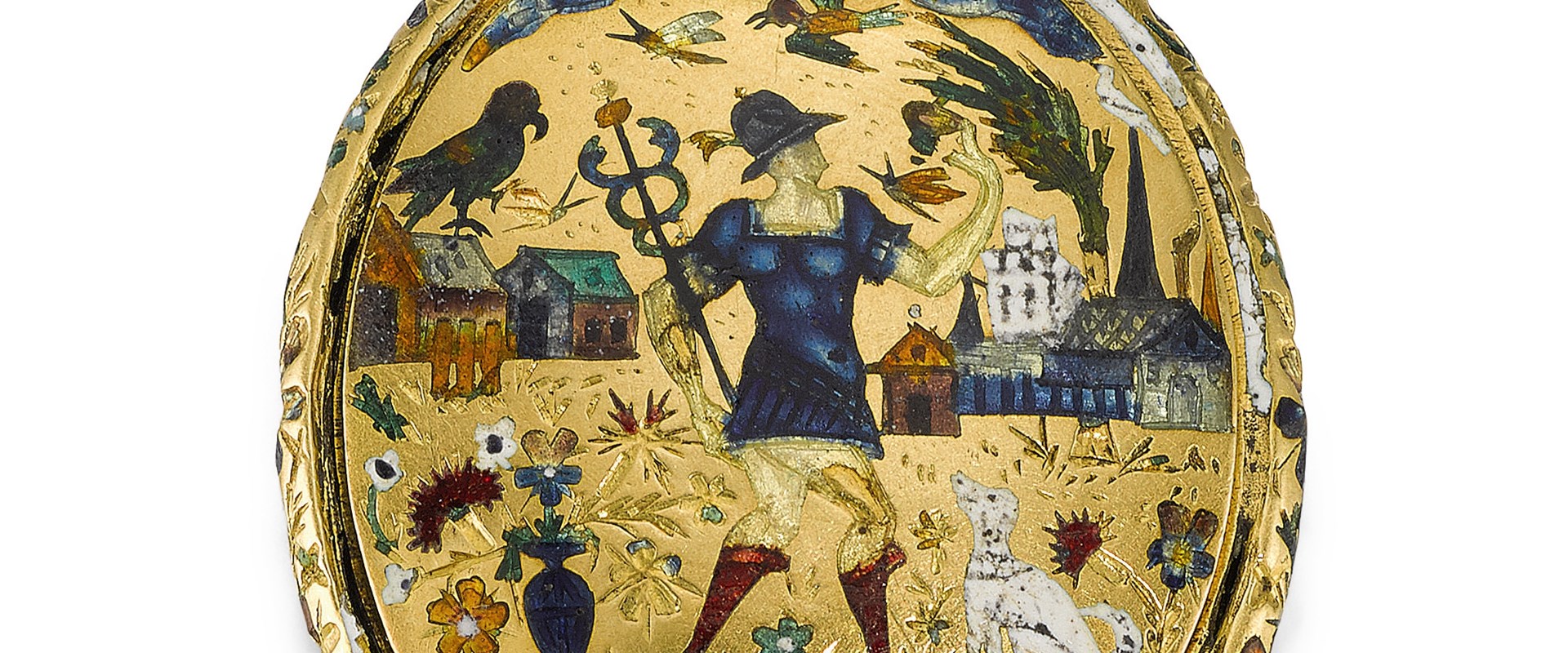The pendant was sold at auction alongside numerous works of art and artefacts from the private collection of the Forbes family whose ancestral home is Fettercairn House in Pitsligo, Aberdeenshire. The Forbes of Pitsligo descend from Sir William Forbes, brother of Alexander Forbes, first Lord Forbes. Both branches were prominent, elite families in the 16th century. The first Lord Forbes married the granddaughter of King Robert II of Scotland and daughter of Douglas, earl of Angus.
The purchase has been made possible thanks to the generosity of Art Fund, The National Lottery and the National Museums Scotland Charitable Trust.
The Jewel is oval in form with a scroll fastening at the top to hold a gold ring. It would have been worn as a pendant on a chain and probably had a pearl or precious stone hanging beneath it. The image on the reverse centres on the figure of Mercury, wearing a winged helmet and striding from left to right. To the right of Mercury’s feet sits a white dog looking upwards, and to the left a vase containing a striking arrangement of vibrant flowers. An urban scene sits in the background, with an array of exotic and domestic birds and insects flying over clusters of buildings. The enormous rectangular almandine garnet on the front of the piece is set prominently amongst a decorative enamelled scheme to enhance its beauty.
During the Scottish Renaissance there was a practice of extensive court gift-giving of jewellery and a vast amount of jewellery was gifted each year by the royal family to Scotland’s elite families. National Museums Scotland will investigate potential links between the Jewel and the Scottish royal court. It will also investigate the potential of its links to the Darnley Jewel, now in the Royal Collection, commissioned at some time between 1564 and 1571 by Lady Margaret Douglas, Countess of Lennox, for her husband Matthew Stewart, Earl of Lennox and Regent of Scotland, and owned by both Horace Walpole and Queen Victoria. It is possible that the Fettercairn Jewel was made by the same jeweller in Edinburgh.
National Museums Scotland has the best collection of Scottish Renaissance material in the world. The bulk of surviving material tends to be items produced in larger quantities – arms and armour, tableware and architectural fragments. Personal and individual objects are much rarer due to their bespoke production and their low survival rates. Jewellery is very rare as, historically, materials were re-used as time passed by; objects like the Fettercairn Jewel are almost unique.
David Forsyth, Principal Curator, Scottish History and Archaeology Department at National Museums Scotland said,
“We are hugely grateful to the Art Fund and The National Lottery for making this important acquisition possible. The Fettercairn Jewel is a rare and outstanding piece of Scottish Renaissance jewellery. The purchase of this piece will significantly enhance the national collections and present new insights into the magnificence of the Renaissance in Scotland.”
Stephen Deuchar, Art Fund director, said:
“We are very happy that National Museums Scotland were successful at auction, and that we could play a part in ensuring that this exceptionally rare and important piece of Scottish Renaissance heritage can remain in Scotland for future generations to enjoy.”
Further information and images from Susan Gray, National Museums Scotland Press Office on 0131 247 4088 or s.gray@nms.ac.uk.
Notes to Editors
-
National Museums Scotland is one of the leading museum groups in the UK and Europe and it looks after collections of national and international importance. The organisation provides loans, partnerships, research and training in Scotland and internationally. Our individual museums are the National Museum of Scotland, the National Museum of Flight, the National Museum of Rural Life and the National War Museum. The National Museums Collection Centre in Edinburgh houses conservation and research facilities as well as collections not currently on display.
-
The National Museum of Scotland is the most popular museum in the country outside of London (source: Association of Leading Visitor Attractions). The National Museum of Scotland was awarded ‘Gold’ Level Green Tourism Visitor Attraction status in 2016.
-
The Fettercairn Jewel was acquired at auction and National Museums Scotland was represented at auction by Geoffrey Munn, jewellery specialist for BBC television’s Antiques Roadshow.
-
Art Fund is the national fundraising charity for art. In the past five years alone Art Fund has given £34 million to help museums and galleries acquire works of art for their collections. It also helps museums share their collections with wider audiences by supporting a range of tours and exhibitions, and makes additional grants to support the training and professional development of curators. Art Fund is independently funded, with the core of its income provided by 123,000 members who receive the National Art Pass and enjoy free entry to over 240 museums, galleries and historic places across the UK, as well as 50% off entry to major exhibitions and subscription to Art Quarterly magazine. In addition to grant-giving, Art Fund’s support for museums includes Art Fund Museum of the Year (won by the V&A, London, in 2016) and a range of digital platforms.Find out more about Art Fund and the National Art Pass at www.artfund.org. For further information please contact Madeline Adeane, Press Relations Manager, madeane@artfund.org / 0207 225 4804
-
From the archaeology under our feet to the historic parks and buildings we love, from precious memories and collections to rare wildlife, the Heritage Lottery Fund (HLF) use National Lottery players' money to help people across the UK explore, enjoy and protect the heritage they care about. www.hlf.org.uk. @heritagelottery. For further information please contact Shiona Mackay on 01786 870638/07779 142890 (shionamackay1@btinternet.com) or Jon Williams on 0207 591 6035 (jonw@hlf.org.uk)


